Mostly unfamiliar artists from parts of the world we rarely incorporate into our viewing patterns are front and center in the exhibit Conflict: Perspectives, Positions, Realities in Central European Art at Slought Foundation.
The experiences of this group of 11 artists from Central Europe, is so different from ours. The concerns of people uprooted from their lands, beset by first-hand experiences of war, or unmoored by major political and cultural shifts creates art different in content and intent from our own–and gives context to several other shows I’ve seen recently, namely Moscow Plastic Arts at Arcadia (see post), Romania Redrawn at Photo West (see post), and a show of Bulgarian art at Kelly Writers House.
The exhibit of mostly videos and photo-based work includes a couple of big-name artists–Marina Abramovic and Braco Dimitrijevic–but the work that really drew me in comes from others, many of them younger. The videos stole the show.
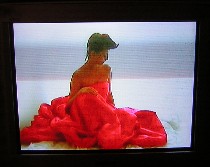 Sejla Kameric’s spectacular video is of a decadent Western World power, personified by a woman dressed in a voluptuous red satin gown in a voluptuous white space, her computer/sci-fi voice-over delivering ironic dicta (they bring to mind George Bush and other American propaganda) of how the rest of the planet must conform to her decadent ideals. Her hair has an aerodynamic pompador that suggests Louis XV and Star Trek in one fell swoop, while her body’s motions bring to mind an Alice in Wonderland caterpillar and Jabba the Hutt (left, still shot from Kameric’s video).
Sejla Kameric’s spectacular video is of a decadent Western World power, personified by a woman dressed in a voluptuous red satin gown in a voluptuous white space, her computer/sci-fi voice-over delivering ironic dicta (they bring to mind George Bush and other American propaganda) of how the rest of the planet must conform to her decadent ideals. Her hair has an aerodynamic pompador that suggests Louis XV and Star Trek in one fell swoop, while her body’s motions bring to mind an Alice in Wonderland caterpillar and Jabba the Hutt (left, still shot from Kameric’s video). 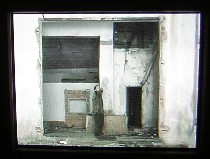 “Plastic Bag Kung Fu,” from Eric Binder, shows a man juggling airy plastic bags–the kind you get at the supermarket–in depressed, decaying locales. The trope and the action are both pretty funny, and pretty depressing all at once. Let them eat air instead, while the international trade cartel provides these cheesy bags to every country around the globe (right, still shot from “Plastic Bag Kung Fu”).
“Plastic Bag Kung Fu,” from Eric Binder, shows a man juggling airy plastic bags–the kind you get at the supermarket–in depressed, decaying locales. The trope and the action are both pretty funny, and pretty depressing all at once. Let them eat air instead, while the international trade cartel provides these cheesy bags to every country around the globe (right, still shot from “Plastic Bag Kung Fu”).The joke movie of Maya Bjevic (my picture didn’t come out; sorry) is definitely not “The Aristocrats.” The performers sit in a Euro-style cafe with stockings pulled over their faces, portraits of military strong-men on the walls behind them. Unbearable long pauses introduce each joke while the distorted faces and the milieu sink in. The jokes are bitter bits of gallows humor, the anonymity of the masked faces a protection from who knows which enemy. The state comes to mind as enemy number one.
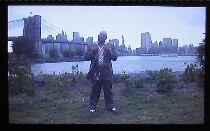 In “Joy Division,” the artist performs a haunting lament of a song (in a foreign language), while standing on the banks of a river, a skyline in the distance. The video is from Bosnian artist Nebojsa Seric Soba, and there he is with an enormous paunch and his white, David Letterman socks in loafers, looking oddly divided from the world of commerce, the sunlit city behind him where it’s business as usual. Slought’s Aaron Levy wrote in an email, “The location of that video is actually at DUMBO, if I understand correctly.” While I was in the gallery, Levy mentioned to me that Soba had an epiphany while in the trenches that there had to be another way than war. At that moment he became an artist, although no such thought had ever crossed his mind previously. Noodling around the web, I found that Soba then created an earthwork at the front, based on Mondrian’s “Broadway Boogie Woogie.” Honestly. So there you have it. Art earthwork vs. military earthwork. Which would you pick (left, still shot of “Joy Division,” by Soba)?
In “Joy Division,” the artist performs a haunting lament of a song (in a foreign language), while standing on the banks of a river, a skyline in the distance. The video is from Bosnian artist Nebojsa Seric Soba, and there he is with an enormous paunch and his white, David Letterman socks in loafers, looking oddly divided from the world of commerce, the sunlit city behind him where it’s business as usual. Slought’s Aaron Levy wrote in an email, “The location of that video is actually at DUMBO, if I understand correctly.” While I was in the gallery, Levy mentioned to me that Soba had an epiphany while in the trenches that there had to be another way than war. At that moment he became an artist, although no such thought had ever crossed his mind previously. Noodling around the web, I found that Soba then created an earthwork at the front, based on Mondrian’s “Broadway Boogie Woogie.” Honestly. So there you have it. Art earthwork vs. military earthwork. Which would you pick (left, still shot of “Joy Division,” by Soba)?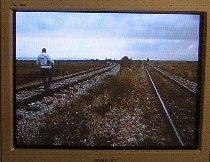 Danica Dakic’s video of a man taking an existential risk by banging a drum as he walks up and back on train tracks made me nervous indeed. I worried that, with all that thumping, he wouldn’t hear the train in time to get off the tracks (right, still shot from Dakic’s video).
Danica Dakic’s video of a man taking an existential risk by banging a drum as he walks up and back on train tracks made me nervous indeed. I worried that, with all that thumping, he wouldn’t hear the train in time to get off the tracks (right, still shot from Dakic’s video).  A series of large drawings of musclemen in itty bitty swim suits by video artist Laszlo Revesz were odd — serious, yet silly and vulnerable — and in the political context seemed to be either about dictatorships or a false focus on some wrong-headed sense of beauty. Hey, I could go with either one of those. Denica Lehocka’s sweet abstractions of what looked like vegetables, a chair, dishes, etc., seemed a little odd in this context, except perhaps for the notion of the ordinary under threat (left, three of Revesz’s strongmen).
A series of large drawings of musclemen in itty bitty swim suits by video artist Laszlo Revesz were odd — serious, yet silly and vulnerable — and in the political context seemed to be either about dictatorships or a false focus on some wrong-headed sense of beauty. Hey, I could go with either one of those. Denica Lehocka’s sweet abstractions of what looked like vegetables, a chair, dishes, etc., seemed a little odd in this context, except perhaps for the notion of the ordinary under threat (left, three of Revesz’s strongmen).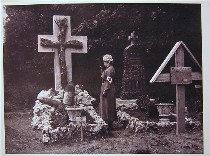 Of the photos, I loved this one from Michael Milunovic for its sheer loopiness and complexity.
Of the photos, I loved this one from Michael Milunovic for its sheer loopiness and complexity.
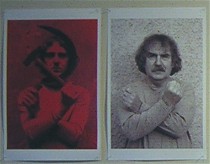 Also Sandor Pinzcehelyi Sandor’s repeating pair of pictures of himself with hammer and sickle and then empty-handed were more interesting I thought for the age element. After all, the loss of political certainty and the past is too superficial a thought, but in the context of how age changes our point of view and makes us less naive about ideologies, an element of welcome ambiguity is introduced (left, detail).
Also Sandor Pinzcehelyi Sandor’s repeating pair of pictures of himself with hammer and sickle and then empty-handed were more interesting I thought for the age element. After all, the loss of political certainty and the past is too superficial a thought, but in the context of how age changes our point of view and makes us less naive about ideologies, an element of welcome ambiguity is introduced (left, detail).
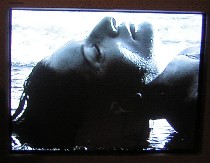 The Abramovic video (image right) showed her head resting on the shore as waves rushed underneath. I kept thinking the waves would ultimately cover her face, but that moment never came while I stood there. The Dimitrijevic video showed tigers and lions amid art–a version of this work has shown before at Slought. The best part of this was the title of the segment the “Golden Autumn of Georgio de Chirico,” the tigers pacing amid a space with gold-leaf shapes applied to the stones of a wall, looking like they were wafting in the air, and a sculptured head on a pedestal.
The Abramovic video (image right) showed her head resting on the shore as waves rushed underneath. I kept thinking the waves would ultimately cover her face, but that moment never came while I stood there. The Dimitrijevic video showed tigers and lions amid art–a version of this work has shown before at Slought. The best part of this was the title of the segment the “Golden Autumn of Georgio de Chirico,” the tigers pacing amid a space with gold-leaf shapes applied to the stones of a wall, looking like they were wafting in the air, and a sculptured head on a pedestal.
As our president grows more and more convinced that he is right and the rest of the world is a) wrong and b) not worth communicating with, voices rarely heard seem to have more and more to say to correct our out-of-whack fantasies of the world.
I am thoroughly struck how these artists, working in media with real people, have not gone into the kind of fantasy worlds that our own young artists are inhabiting. I love those fantasies, but I worry that they are reflections of a decadent society, that decadent society that Kamaric and Binder have captured so succinctly.
The show was curated by Lorand Hegyi, director of Le Musée d’art moderne de Saint-Etienne, France.









